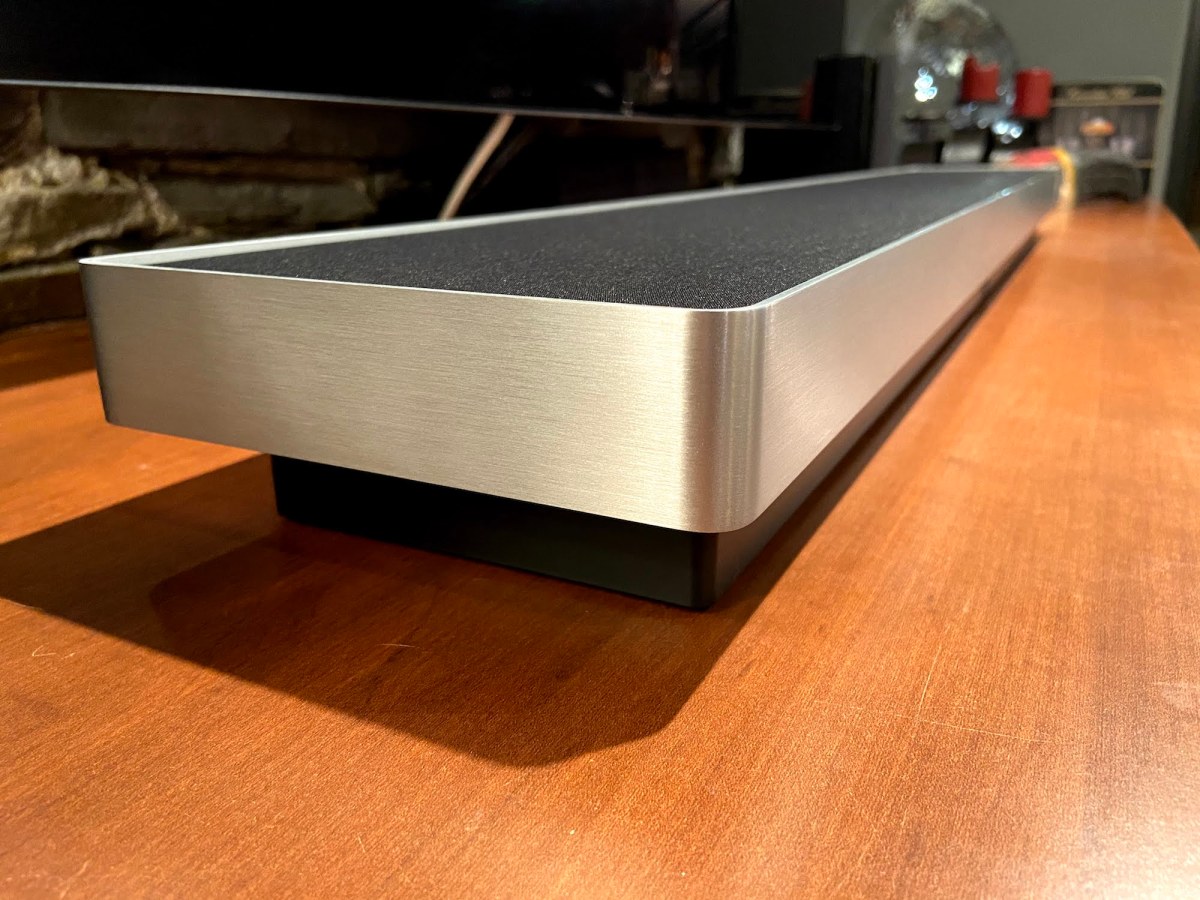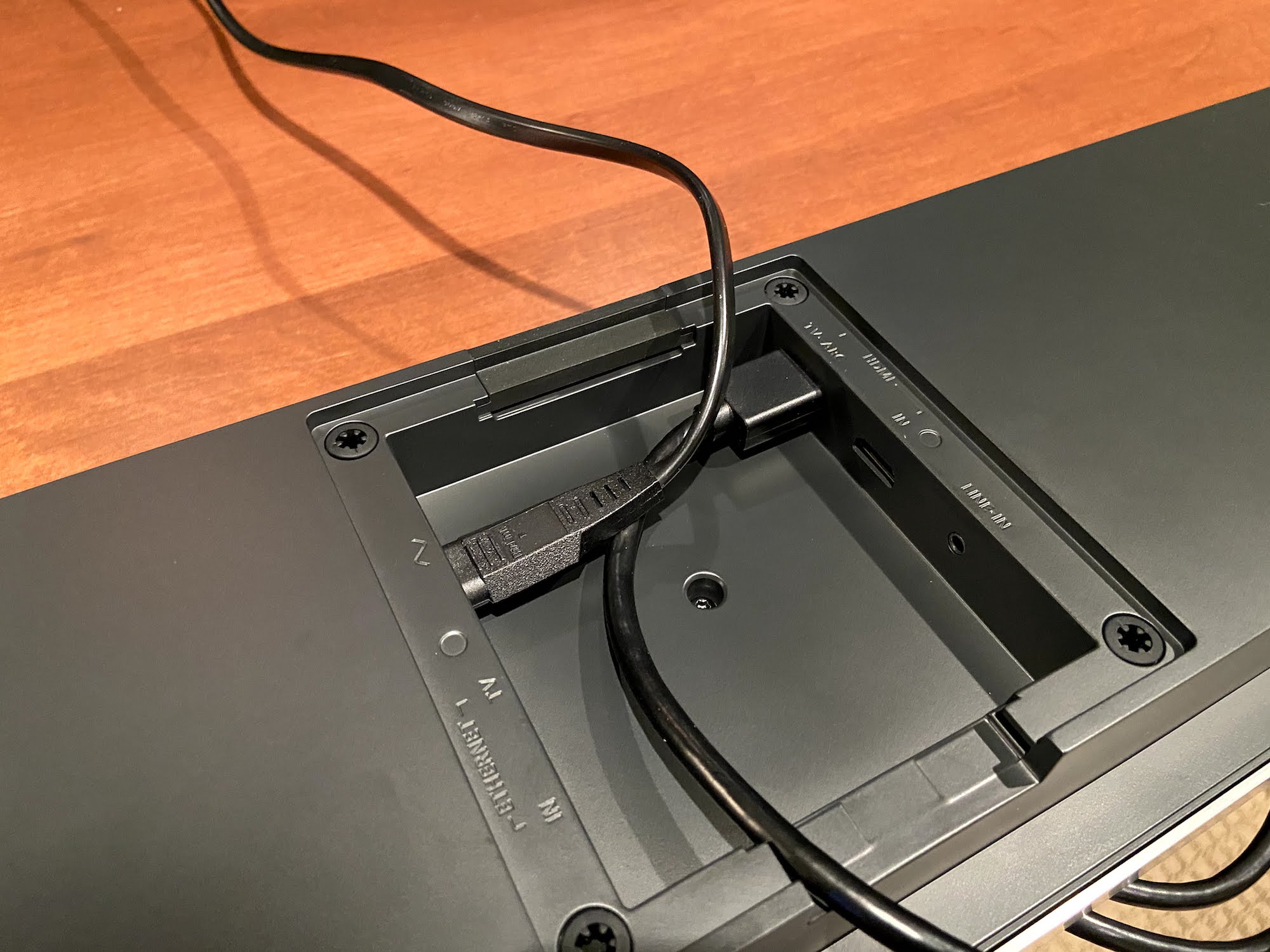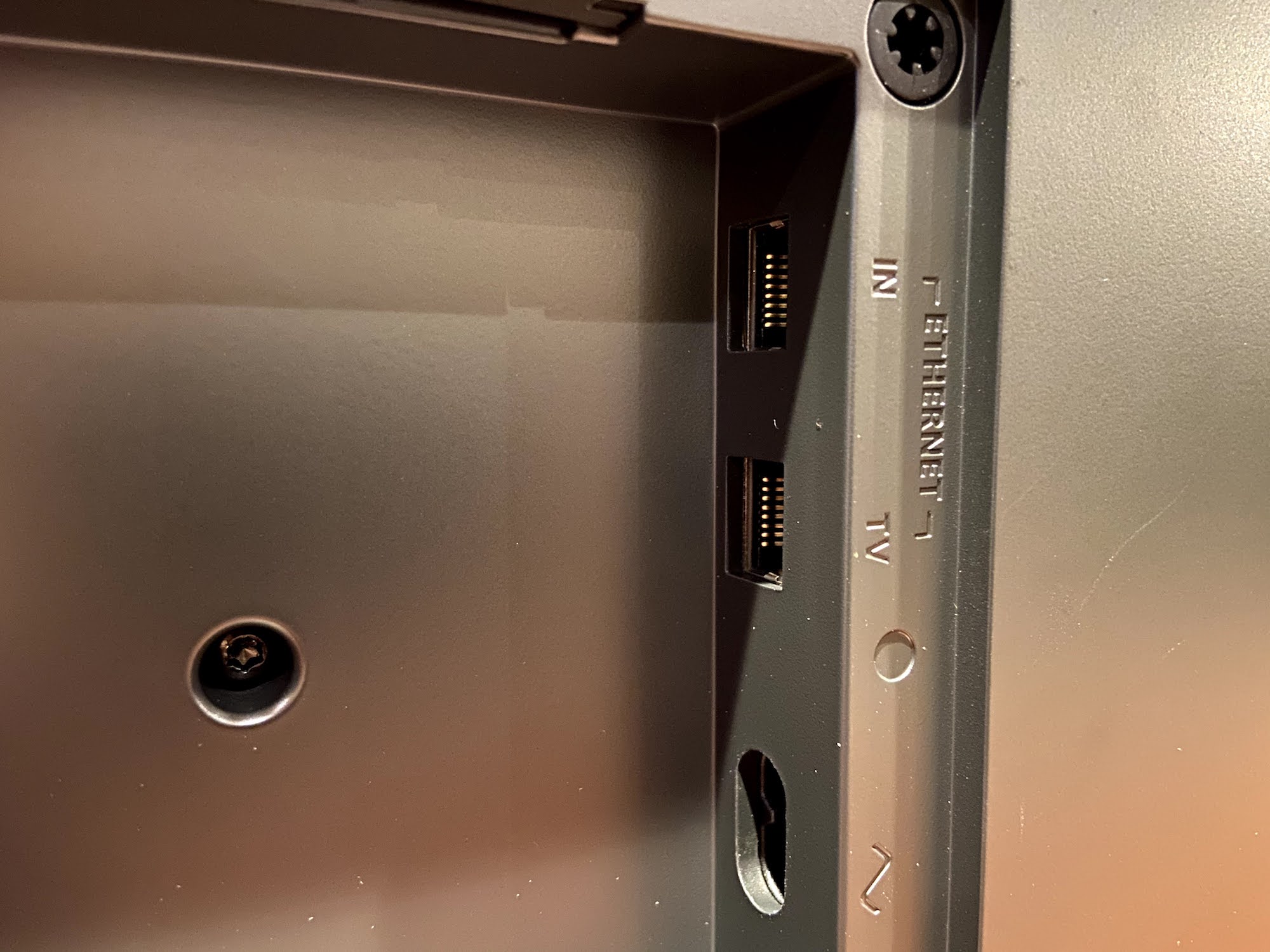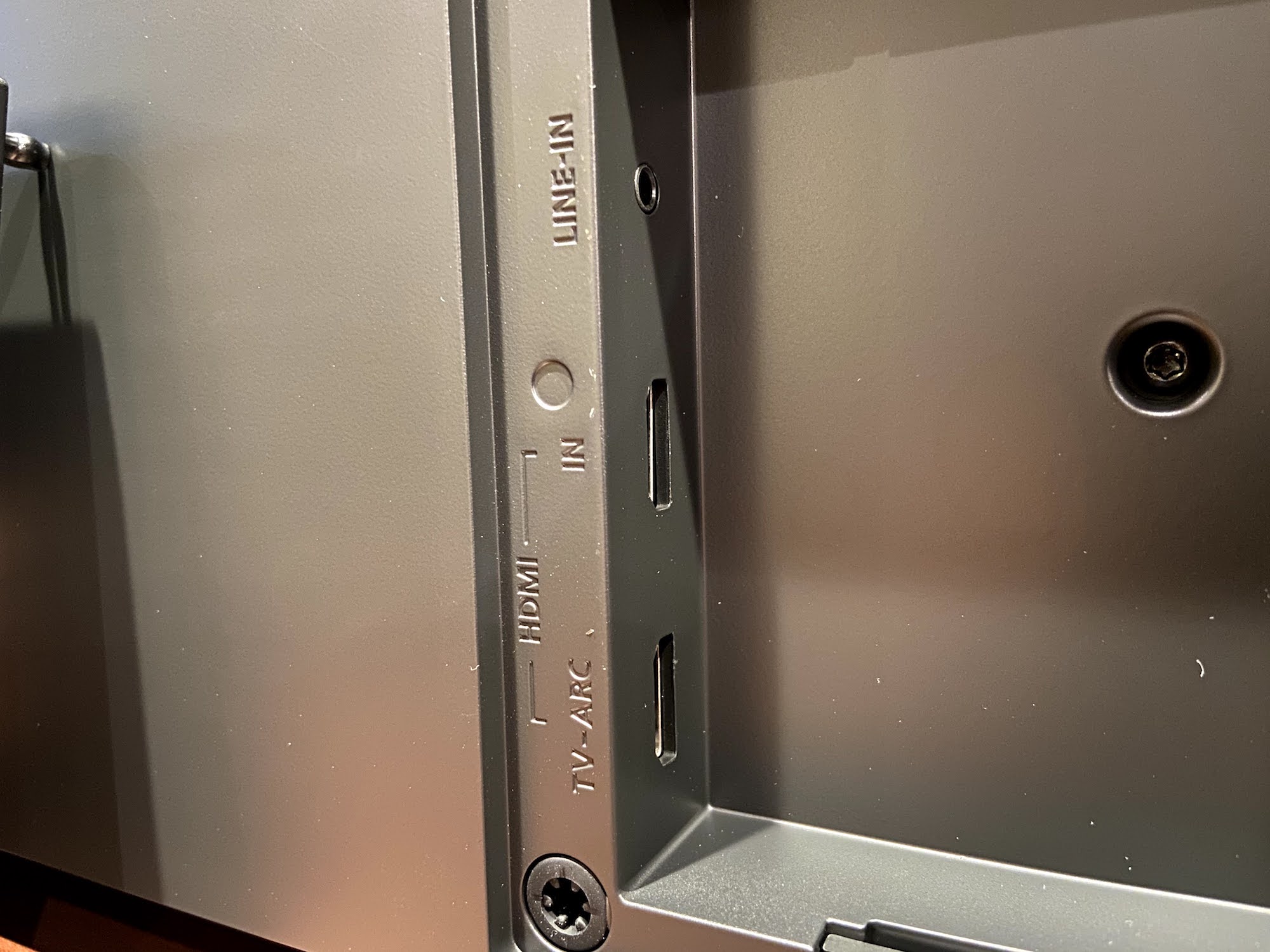“If it had better Dolby Atmos, this gorgeous soundbar would be worth the price.”
- Gorgeous design
- Deliciously deep and resonant bass
- Tons of EQ customization options
- Airplay 2, Bluetooth, and Chromecast
- Simple and flexible wall-mount
- Expensive
- Unimpressive Dolby Atmos
- Only one HDMI input
- B&O App needs improvement
There is now an incredible array of excellent soundbars to pick from for those who want the ultimate in home theater sound simplicity.
With prices that start as low as $150, anyone can get much better TV sound for a relatively tiny investment.
But what if your tastes run to the more exotic side of things? What if you don’t just want your soundbar to sound good, but to also make a visual statement? That is why Bang and Olufsen (B&O), the legendary Danish audio marque, has developed the Beosound Stage, a Dolby Atmos-capable soundbar that starts at $1,750 but can quickly ascend to $2,600 if you choose one of the optional wood finishes.
B&O has never been the brand you buy strictly for how it sounds, but let’s agree that if you’re paying this much money for a soundbar, it had better sound and look fantastic. Does it succeed?
What’s in the box?
The Beosound Stage comes with a power cable, a six-foot HDMI cable, and a remarkably small plastic bag with wall-mounting hardware and a wall-mount template. The box itself is easily recycled cardboard, but the extensive foam padding inside might prove to be a challenge to dispose of without tossing them in a landfill.
Design

B&O’s design signatures are all over the Beosound Stage, which is a testament to how distinctive those signatures are because B&O didn’t actually design the exterior of the speaker at all. That job fell to a third party — Norm Architects — which took its inspiration from the vintage B&O Beogram 4000 turntable.
The Beosound Stage is stunning to behold, with perfectly rounded corners and seamlessly integrated controls.
Especially when the soundbar is clad in the optional smoked oak and grey wood materials ($2,600), the similarity is obvious.
But even in the more affordable (a relative term with B&O’s products) natural aluminum and black wardrobe of our review unit, the Beosound Stage is stunning to behold, with perfectly rounded corners and seamlessly integrated controls.
Your other options are Bronze Tone/Warm Taupe, or a limited edition Anthracite, both of which will run you $2,025.
I’m of the opinion that soundbars should, if at all possible, hide from view, or at least, be inconspicuous. But B&O takes the opposite approach, by making the Beosound Stage an object that demands attention.
To a degree, this makes sense. After all, whether you’re using it to play audio or not, it will be part of your room’s decor, so why not make it a conversation piece? On the other hand, I found that when watching TV even in a darkened room, the broad band of brushed aluminum presented an unwanted source of reflected light, which I had to studiously ignore.

Granted, I was using the Beosound Stage in its tabletop mode. If you wall mount it, that aluminum border shrinks to a barely-there, razor-thin line around the otherwise perfectly black fabric that hides the drivers beneath.
When sitting on a flat surface, the Beosound Stage stands just a hair over three inches tall. That’s shorter than the Sonos Arc and should keep the Stage from interfering with even the lowest TV picture. At 43 inches wide, it’s narrower than many top-tier soundbars, but it’s also much deeper at a hair over 6.5 inches, so you’ll need to make sure you have room in front of your TV.
To wall-mount it, you lift the soundbar into a vertical position and rotate it 180 degrees counterclockwise, which places the controls on the top edge, and cleverly, almost perfectly preserves the angle of the tweeters. There are two downsides to this position — it hides the two small LED indicator lights from view and you’ll need some extra space: It’s just over 6.5 inches tall.
Props must be given to the engineers who designed the underbelly of the Beosound Stage. It has three identical square panels with rubberized surfaces. When sitting on a table, they act as feet, but when wall-mounted, they double as simple keyhole mounting slots.
Unlike some soundbars that require expensive, optional wall-mount brackets, all you need to get the Stage up on a wall are two small plastic collars, which are included.
Another clever detail: All of the cable connections can exit the bottom of the soundbar in virtually any direction, giving you the ability to run the cables through your wall, or through a conduit.
Set up and connections
Physically, the Beosound Stage is a study in elegant simplicity. The procedure for getting it set up is significantly less simple.
Once the soundbar is connected to power and (optionally) your TV via HDMI ARC (or eARC), the setup process is guided by the B&O app on a phone or tablet (both iOS and Android versions are available). Unfortunately, the B&O app can’t complete the process on its own, and partway into the setup, it passes you over to the Google Home app.
If you’ve used the Google Home app previously, you’ll be spared the extra step of signing into Google and configuring your home, but if you’ve never used Google Home, I recommend installing it first before trying to set up the Beosound Stage.

Eventually, you’ll be returned to the B&O app to finish up. The whole thing only takes about 10 minutes, but it’s awkward and not what I expect from a B&O as a brand.
It’s not entirely B&O’s fault. Because Google now makes the Google Home step a requirement for any audio product that wants to include Chromecast functionality, B&O’s hands were tied. Other soundbar companies, like Bose and Sonos, which offer Apple’s AirPlay 2 technology, have so far declined to add Chromecast to their products. If the cost of doing so is making their setups more cumbersome, it’s easy to see why they haven’t.
The Beosound Stage doesn’t come with a remote control, although you can buy a B&O remote if you want to use one. Instead, just like the Sonos Arc, you adjust the soundbar’s settings via the B&O app on a phone or tablet. When streaming music, the volume control is handled via the app. When listening to your TV, you use your existing TV remote to control the volume via HDMI CEC.

The only problem with this arrangement is that it requires you to connect the Stage via HDMI ARC (or eARC) to your TV. If your TV only has an optical output, you’ll need to buy an optical-to-HDMI adapter (B&O doesn’t sell them), you won’t be able to control the volume from your TV’s remote, and you’ll be limited to just 5.1 Dolby Digital Surround Sound.
There are also two Ethernet ports. Normally when we see this on a device (like a Sonos Port), one port acts as the ethernet input while the other lets you share the network connection to another device.
On the Beosound Stage, the second port is actually used to communicate with a 2019 or newer LG OLED TV, to enable control of both the TV and the soundbar via the lavishly designed (and priced) $375 Beoremote One.
Puzzlingly, even though the Stage doesn’t offer an optical input, it does have a 3.5mm stereo analog jack. These days, I’m not entirely sure what you would use it for, but it’s there if you need it.
B&O sees the Beosound Stage as a fully self-contained sound system. There is no way to add additional components.
The Stage gives you just a single HDMI input, which we presume is meant to compensate for the one input on your TV that the soundbar requires. That input lets you passthrough signals up to 4K at 60Hz, in full Dolby Vision HDR, but it’s still just one port. I would have liked it if B&O had included a few more, but in fairness, the back connection panel is pretty tight on space as it is.
A much more troubling omission is the inability to expand the Beosound Stage’s capabilities with additional speakers. Most of the soundbars we’ve reviewed either come with their own wireless subwoofers and satellite surround speakers, or you can add them later if you wish.
That’s not the case with the Stage. B&O sees it as a fully self-contained sound system and there is no way to add additional components for an even more immersive experience.
We’ll discuss whether or not this is an issue for overall sound quality in a moment.
In addition to its wired connections, the Beosound Stage gives you all three major wireless audio standards too. Bluetooth, AirPlay 2, and Chromecast are all available.
During my testing, I encountered an odd bug where the Stage refused to give me TV audio after turning on my TV. It only happened twice, and both times I was able to resolve it by unplugging and re-plugging the power cord. B&O took the speaker back and tried to duplicate the problem but it didn’t reoccur.
App, streaming, and controls
The B&O app works well but also feels like a work in progress at times. There are four tabs: Home, Multiroom, Music, and Radio.
Home is where you control all of the Beosound Stage’s settings from EQ to speaker orientation. Multiroom lets you group multiple B&O speakers, but given I only had one speaker, that’s not a function I was able to test.
The Music tab gives you an interface to pick music from the sources that B&O has been able to integrate, but it’s a limited list: Songs on your phone, songs on your home network if you have a DLNA server or Deezer. It lists Spotify too, but this is simply a shortcut to the Spotify app.
A search tool is shown, but it only works with Deezer, not your personal music sources.
Thanks to the Beosound Stage’s 4-inch woofers you get copious amounts of thunderous bass — no sub needed.
The Radio tab is where you’ll find streaming terrestrial stations from TuneIn.
Frankly, when compared to the power and control of a system like Sonos, the B&O app just doesn’t cut it as a way to find and listen to music. You’re far better off picking your favorite music app and then using AirPlay 2, Bluetooth, or Chromecast to stream to the Beosound Stage.
Sound quality

The Beosound Stage doesn’t disappoint on sound quality. Whether listening to the soundtrack of a Marvel action movie or streaming your favorite tunes, you’re treated to a silky-smooth performance that easily captures and reproduces the full range of frequencies.
Soundbars generally have trouble with deep, low-end bass, which is why so many of them ship with a wireless subwoofer. But thanks to the Beosound Stage’s four independently powered 4-inch woofers, which have been grouped together in pairs, you get copious amounts of thunderous bass — no sub needed.
The speaker’s remaining seven drivers and amps (four midrange and three tweeters) take care of the rest, with excellent separation and definition. Fire up some Norah Jones tracks and you can hear her voice soar effortlessly above the instruments, while never missing a single piano note or resonant thrum from a bass.
The app’s equalizer and listening modes give you a huge amount of control over the sound. Not only can you independently adjust bass and treble, but you can also select from four preset modes like TV (which enhances dialog), Movie (bet you can guess that one), Music, and Night Listening which reduces large jumps in volume.

But there’s one area where the Beosound Stage falls a bit short: Dolby Atmos and 5.1 surround sound.
Make no mistake, the Stage is a Dolby Atmos-capable soundbar and in fact, it can reproduce that sound via Dolby’s lossless, 24-bit TrueHD format if you connect it to a Blu-ray player.
However, it is not a discrete 5.1.2 channel soundbar. There are no upward-firing height channel drivers that bounce sounds off the ceiling for a dramatic over-your-head effect and no dedicated surround drivers.
As a three-channel speaker, it relies entirely on virtualization for both Atmos and 5.1 surround sound. Virtualization means that B&O has employed some very sophisticated psychoacoustic techniques to try to trick your brain into thinking that there are extra speakers in your room.
Unfortunately, it doesn’t entirely succeed.
If you imagine your TV screen as the source of the sound, the Beosound Stage convincingly expands that screen into a much larger rectangle, making it seem like there are speakers in the upper and lower corners of your space (and in the middle too). But that sound doesn’t really extend outward very far, and it barely registered for me in the height or surround positions.
This is not the soundbar for those who are trying to replace a 5.1 surround sound or Dolby Atmos home theater setup.
Here’s where we get into the problem with B&O’s decision to make the Beosound Stage non-expandable. Ordinarily, if you want to enhance a soundbar’s level of immersion, you’d add extra speakers. LG, Samsung, Bose, and Sonos all offer this as an option. But the Beosound Stage is a resolute soloist — you either appreciate what this speaker has to offer, or you choose something else.
What are we to make of this situation? Let’s put it this way: As a room-filling music speaker, the Beosound Stage is truly a joy to listen to. And if you’re looking to give your movie and TV soundtracks a thrilling boost that you can feel, without cluttering your space with subwoofers and surrounds, it’s an unqualified success.
But this is not the soundbar for those who are trying to replace a full 5.1 surround sound or 5.1.2 Dolby Atmos home theater setup. If this is your goal, you can save some money and get a much more immersive sound elsewhere.
Our take
The beautiful but very expensive B&O Beosound Stage is a fabulous one-speaker solution for room-filling music or TV audio. But it falls short as a way of adding the immersive qualities of Dolby Atmos.
Is there a better alternative?
Given that the Beosound Stage doesn’t really deliver on Dolby Atmos, you can get the excellent $800 Bose Soundbar 700 for less than half the price. I think it looks terrific, and it has the benefit of being expandable via wireless subwoofers and surround modules and it would still cost less than the mid-price Beosound Stage.
If Atmos is a must-have, you can’t go wrong with the Sonos Arc. It’s the same price as the Bose Soundbar 700, and it’s also easily expanded with optional wireless speakers.
Both the Bose and the Sonos soundbars also give you a choice of voice assistant: Alexa or Google Assistant, something the Beosound Stage lacks.
How long will it last?
Beautifully crafted and solidly built, I expect the Beosound Stage should last for years if not decades. It is backed by a 36-month warranty from B&O, which is one of the longest warranties in the industry.
Should you buy it?
If you place an equal emphasis on how your audio and video equipment looks and how it sounds — and your pockets are deep enough to support that approach — yes, by all means buy the B&O Beosound Stage. As long as you’re aware of its limitations, you’ll be very happy with it. Everyone else should consider the many other great (and less expensive) options.







